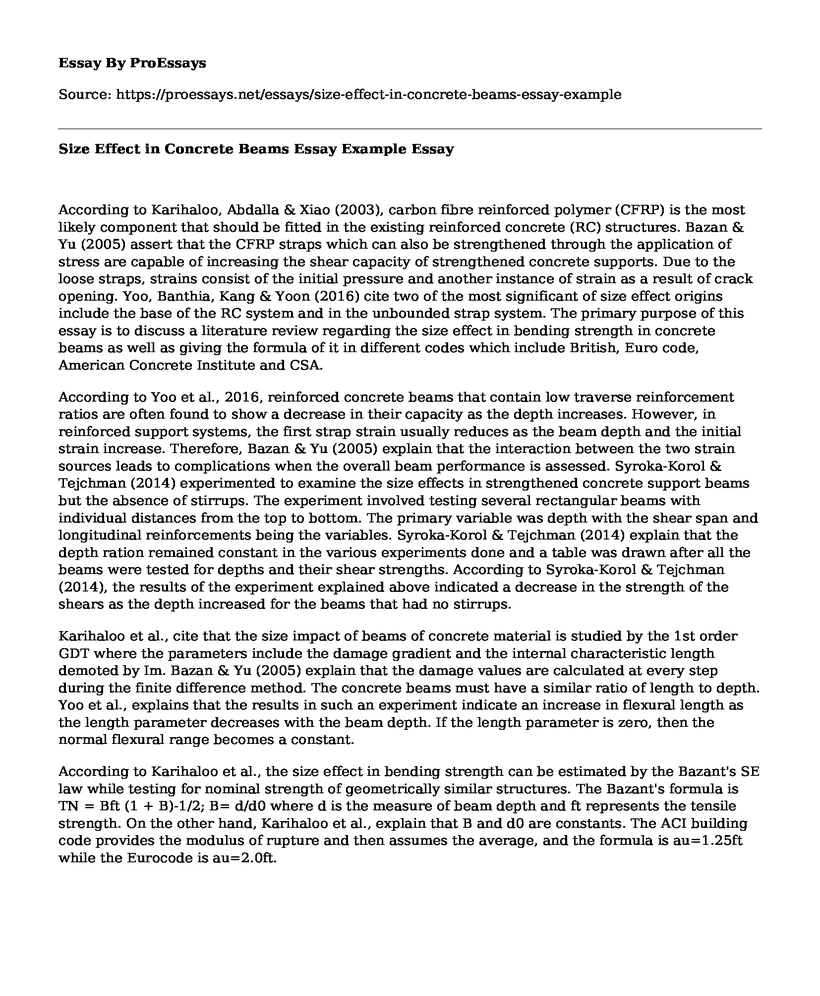According to Karihaloo, Abdalla & Xiao (2003), carbon fibre reinforced polymer (CFRP) is the most likely component that should be fitted in the existing reinforced concrete (RC) structures. Bazan & Yu (2005) assert that the CFRP straps which can also be strengthened through the application of stress are capable of increasing the shear capacity of strengthened concrete supports. Due to the loose straps, strains consist of the initial pressure and another instance of strain as a result of crack opening. Yoo, Banthia, Kang & Yoon (2016) cite two of the most significant of size effect origins include the base of the RC system and in the unbounded strap system. The primary purpose of this essay is to discuss a literature review regarding the size effect in bending strength in concrete beams as well as giving the formula of it in different codes which include British, Euro code, American Concrete Institute and CSA.
According to Yoo et al., 2016, reinforced concrete beams that contain low traverse reinforcement ratios are often found to show a decrease in their capacity as the depth increases. However, in reinforced support systems, the first strap strain usually reduces as the beam depth and the initial strain increase. Therefore, Bazan & Yu (2005) explain that the interaction between the two strain sources leads to complications when the overall beam performance is assessed. Syroka-Korol & Tejchman (2014) experimented to examine the size effects in strengthened concrete support beams but the absence of stirrups. The experiment involved testing several rectangular beams with individual distances from the top to bottom. The primary variable was depth with the shear span and longitudinal reinforcements being the variables. Syroka-Korol & Tejchman (2014) explain that the depth ration remained constant in the various experiments done and a table was drawn after all the beams were tested for depths and their shear strengths. According to Syroka-Korol & Tejchman (2014), the results of the experiment explained above indicated a decrease in the strength of the shears as the depth increased for the beams that had no stirrups.
Karihaloo et al., cite that the size impact of beams of concrete material is studied by the 1st order GDT where the parameters include the damage gradient and the internal characteristic length demoted by Im. Bazan & Yu (2005) explain that the damage values are calculated at every step during the finite difference method. The concrete beams must have a similar ratio of length to depth. Yoo et al., explains that the results in such an experiment indicate an increase in flexural length as the length parameter decreases with the beam depth. If the length parameter is zero, then the normal flexural range becomes a constant.
According to Karihaloo et al., the size effect in bending strength can be estimated by the Bazant's SE law while testing for nominal strength of geometrically similar structures. The Bazant's formula is TN = Bft (1 + B)-1/2; B= d/d0 where d is the measure of beam depth and ft represents the tensile strength. On the other hand, Karihaloo et al., explain that B and d0 are constants. The ACI building code provides the modulus of rupture and then assumes the average, and the formula is au=1.25ft while the Eurocode is au=2.0ft.
Conclusion
In conclusion, the strong size dependence on the bending firmness of concrete beams is related to the tensile strength that is always assumed as a constant. In the experiments conducted in the lab by different professionals, there is evidence of the dependence of size on the rapture modulus among other factors used to evaluate the bending strength of concrete beams.
References
Bazant, Z. P., & Yu, Q. (2005). Designing against size effect on shear strength of reinforced concrete beams without stirrups: I. Formulation. Journal of Structural Engineering, 131(12), 1877-1885.
Karihaloo, B. L., Abdalla, H. M., & Xiao, Q. Z. (2003). Size effect in concrete beams. Engineering fracture mechanics, 70(7-8), 979-993.
Syroka-Korol, E., & Tejchman, J. (2014). Experimental investigations of size effect in reinforced concrete beams failing by shear. Engineering Structures, 58, 63-78.
Yoo, D. Y., Banthia, N., Kang, S. T., & Yoon, Y. S. (2016). Size effect in ultra-high-performance concrete beams. Engineering Fracture Mechanics, 157, 86-106.
Cite this page
Size Effect in Concrete Beams Essay Example. (2022, Oct 23). Retrieved from https://proessays.net/essays/size-effect-in-concrete-beams-essay-example
If you are the original author of this essay and no longer wish to have it published on the ProEssays website, please click below to request its removal:
- Research Paper Example on Stirling Engine
- Positive and Negative Impacts of a Reduction in Global Oil Price Paper Example
- Community Engagement in Engineering Education Paper Example
- Western Sectoral Sanctions on Russian Oil Industry Paper Example
- Oil Industry: Profitable Yet Volatile Global Market - Essay Sample
- Essay Example on Airplane Electrical Power System: An Overview
- Essay on Petroleum Economics: Examining Factors to Make Investment Decisions







